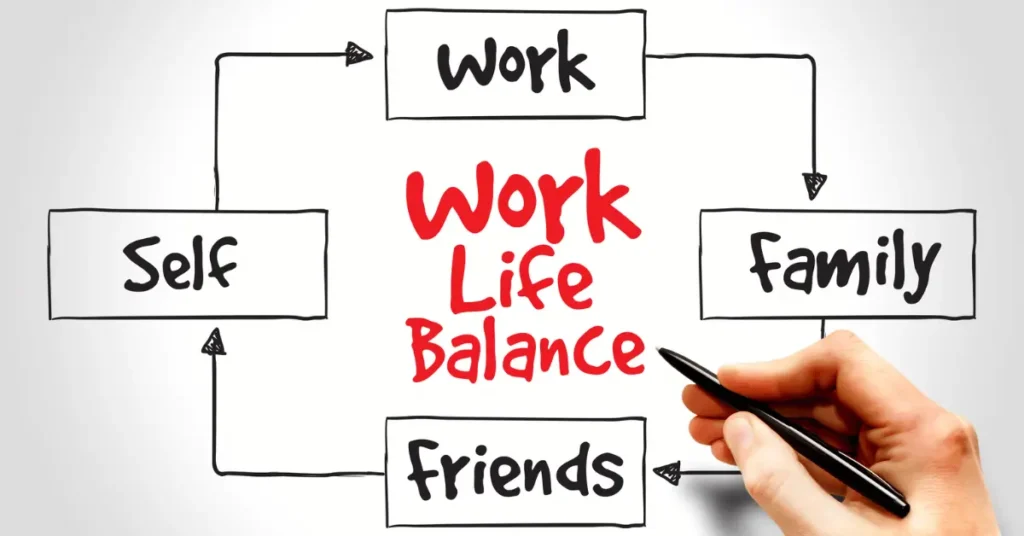Hello, ladies and gents. Every day, I bring you a new health issue, but you do not demonstrate your love. First of all, I’d want to introduce myself; my name is Anas Naseem, and I’ve been a health educator since 2001.
Work-life balance is a notion that has gained popularity in recent years, particularly in light of rapid technological improvements and changing workplace dynamics. In today’s fast-paced world, striking a balance between professional commitments and personal life is critical to overall well-being. This article looks into the complexities of obtaining work-life balance, including definition, problems, advantages, techniques, and real-world examples.
Contents
- 1 Understanding Work-Life Harmony
- 2 Challenges in Achieving Work-Life Harmony
- 3 Benefits of Work-Life Harmony
- 4 Strategies for Achieving Work-Life Harmony
- 5 Practical Tips for Maintaining Work-Life Harmony
- 6 Case Studies: Real-Life Examples of Work-Life Harmony
- 7 Impact of Work-Life Harmony on Organizational Culture
- 8 Future Trends in Work-Life Harmony
- 9 Finale
- 10 Must Read
- 11 Frequently asked questions (faqs)
- 11.1 1. What is work-life harmony, and how does it differ from work-life balance?
- 11.2 2. What are some common challenges people face in achieving work-life harmony?
- 11.3 3. How can technology both help and hinder work-life harmony?
- 11.4 4. What are the benefits of prioritizing work-life harmony?
- 11.5 5. What strategies can individuals employ to achieve work-life harmony?
- 11.6 6. How can organizations contribute to fostering work-life harmony among their employees?6.
- 11.7 7. What impact does work-life harmony have on organizational culture?
- 11.8 8. What are some future trends in work-life harmony?
- 11.9 9. How can individuals proactively maintain work-life harmony in an ever-changing world?
Understanding Work-Life Harmony

Defining Work-Life Harmony
Work-life harmony refers to the ability to effectively manage the demands of work and personal life in a way that promotes overall satisfaction and well-being. Unlike the traditional notion of work-life balance, which implies a strict separation between work and personal life, work-life harmony emphasizes integration and synergy between the two domains.
Differentiating Work-Life Balance and Work-Life Harmony
While work-life balance focuses on achieving equality or equilibrium between work and personal life, work-life harmony recognizes that such a balance may not always be feasible or desirable. Instead, it emphasizes the need for individuals to align their professional and personal commitments in a way that allows for seamless transitions and fulfillment in both areas.
The Psychological Aspect of Harmony
Achieving work-life harmony requires more than just effective time management; it also entails a psychological shift in mindset. It involves cultivating a sense of purpose, fulfillment, and satisfaction in both professional and personal endeavors, thereby minimizing stress and enhancing overall well-being.
Challenges in Achieving Work-Life Harmony
Common Challenges Faced by Professionals
Despite the growing awareness of the importance of work-life harmony, many professionals continue to struggle with balancing their career aspirations with personal obligations. Common challenges include long working hours, unrealistic expectations, and the pressure to constantly be available.
Impact of Technology on Work-Life Harmony
The proliferation of technology has blurred the boundaries between work and personal life, making it increasingly challenging to disconnect from work-related tasks outside of traditional office hours. The constant connectivity facilitated by smartphones and digital devices has led to a phenomenon known as “technostress,” wherein individuals feel overwhelmed by the constant barrage of emails, messages, and notifications.
Cultural and Societal Factors
Cultural norms and societal expectations also play a significant role in shaping individuals’ perceptions of work-life balance. In some cultures, there may be a stigma associated with prioritizing personal life over work, leading to feelings of guilt or inadequacy among those who seek to establish boundaries.
Benefits of Work-Life Harmony
Improved Mental Health
One of the primary benefits of achieving work-life harmony is improved mental health. By minimizing stress and promoting a sense of balance and fulfillment, individuals can reduce the risk of burnout, anxiety, and depression.
Increased Productivity and Job Satisfaction
Contrary to popular belief, prioritizing personal well-being does not necessarily detract from professional success; in fact, it often enhances it. Studies have shown that employees who feel supported in achieving work-life harmony are more engaged, productive, and satisfied with their jobs.
Enhanced Relationships and Personal Fulfillment
Work-life harmony not only benefits individuals professionally but also enriches their personal lives. By devoting time and energy to meaningful relationships, hobbies, and activities outside of work, individuals can experience greater fulfillment and satisfaction in all aspects of their lives.
Strategies for Achieving Work-Life Harmony
Setting Clear Boundaries
One of the most effective strategies for achieving work-life harmony is setting clear boundaries between work and personal life. This may involve establishing designated work hours, creating a separate workspace at home, and communicating expectations with employers and colleagues.
Prioritizing and Time Management Techniques
Effective prioritization and time management are essential skills for maintaining work-life harmony. By identifying priorities and allocating time and resources accordingly, individuals can ensure that they devote sufficient attention to both professional and personal responsibilities.
Utilizing Technology Wisely
While technology can be a double-edged sword when it comes to work-life harmony, it can also be a valuable tool for enhancing productivity and flexibility. By leveraging technology to automate repetitive tasks, streamline communication, and facilitate remote work, individuals can create more opportunities for work-life integration.
Embracing Flexibility and Adaptability
In today’s dynamic work environment, flexibility and adaptability are key attributes for achieving work-life harmony. Rather than adhering rigidly to predefined schedules or expectations, individuals should be willing to adjust their routines and priorities as needed to accommodate changing circumstances.
Practical Tips for Maintaining Work-Life Harmony

Establishing Routines
Establishing consistent routines can help individuals maintain a sense of structure and balance in their lives. This may involve setting aside dedicated time for work, exercise, relaxation, and social activities, ensuring that each aspect of life receives the attention it deserves.
Incorporating Self-Care Practices
Self-care is an essential component of work-life harmony, as it enables individuals to recharge and rejuvenate both physically and mentally. This may involve engaging in activities such as exercise, meditation, hobbies, or spending time outdoors.
Seeking Support Systems
Building a strong support network is crucial for navigating the challenges of work-life harmony. Whether it’s seeking advice from colleagues, confiding in friends or family members, or accessing professional counseling services, having a support system in place can provide invaluable guidance and encouragement.
Creating a Supportive Work Environment
Employers also play a critical role in fostering work-life harmony among their employees. By implementing policies and initiatives that prioritize employee well-being, such as flexible work arrangements, wellness programs, and mental health resources, organizations can create a more supportive and inclusive workplace culture.
Case Studies: Real-Life Examples of Work-Life Harmony
Success Stories from Various Industries
There are numerous examples of individuals and organizations that have successfully achieved work-life harmony. From high-profile executives to everyday professionals, these success stories serve as inspiration for others seeking to strike a balance between their professional and personal lives.
Challenges Faced and Overcome
Many of these success stories are accompanied by challenges and setbacks along the way. Whether it’s overcoming work-related stress, navigating personal crises, or managing conflicting priorities, these individuals demonstrate resilience, perseverance, and resourcefulness in their pursuit of work-life harmony.
Lessons Learned
By sharing their experiences and insights, these individuals offer valuable lessons and strategies for others seeking to achieve similar success. Whether it’s learning to delegate tasks, saying no to additional commitments, or prioritizing self-care, these lessons can help guide others on their journey toward work-life harmony.
Impact of Work-Life Harmony on Organizational Culture
Role of Companies in Facilitating Work-Life Harmony
Organizational culture plays a significant role in shaping employees’ perceptions and experiences of work-life harmony. Companies that prioritize employee well-being and recognize the importance of work-life balance are more likely to attract and retain top talent.
Strategies Employed by Leading Organizations
Leading organizations understand that promoting work-life harmony is not just a moral imperative but also a strategic advantage. They invest in initiatives such as flexible work arrangements, telecommuting options, and wellness programs to support their employees’ holistic well-being.
Employee Satisfaction and Retention Rates
The impact of work-life harmony on organizational culture is evident in metrics such as employee satisfaction and retention rates. Companies that prioritize work-life balance tend to have higher levels of employee engagement, loyalty, and productivity, ultimately contributing to their bottom line.
Future Trends in Work-Life Harmony
Remote Work and Virtual Collaboration
The COVID-19 pandemic has accelerated the adoption of remote work and virtual collaboration, ushering in a new era of flexibility and autonomy for many professionals. As remote work becomes more commonplace, individuals will have greater opportunities to design their own work schedules and routines, thereby enhancing work-life harmony.
Emphasis on Well-Being Programs
In response to the growing awareness of the importance of mental health and well-being, organizations are placing greater emphasis on implementing comprehensive wellness programs. These programs may include initiatives such as mindfulness training, stress management workshops, and access to mental health resources, all of which contribute to a culture of work-life harmony.
Technological Innovations Shaping Work-Life Integration
Advancements in technology continue to shape the way we work and live, offering new opportunities for integrating professional and personal life. From productivity tools and communication platforms to wearable devices and virtual reality, technology has the potential to facilitate greater flexibility, efficiency, and balance in our daily lives.
Finale
In Finale, achieving work-life harmony is not just a lofty ideal but a practical necessity in today’s fast-paced world. By understanding the challenges, benefits, and strategies associated with work-life harmony, individuals can take proactive steps to align their professional and personal commitments in a way that promotes overall well-being and fulfillment. Whether it’s setting clear boundaries, prioritizing self-care, or seeking support from others, everyone has the power to create a more harmonious and balanced life.
Must Read
- 13 Foods That Promote Mental Clarity in 2024
- The Power of Self-Compassion: Learning to Love Yourself in 2024
- How to Practice Mindfulness Anywhere in 2024
- Coping with Stress: Practical Tips for Daily Life in 2024
- Overcoming Panic Attacks: Strategies That Work
- Understanding Depression: Causes, Symptoms, and Treatments in 2024
- 7 Effective Ways to Boost Your Mood Instantly
- The Ultimate Guide to Managing Anxiety Naturally in 2024
- How to Reduce Mental Stress at Home in 2024: A Comprehensive Guide
- 10 Essential Facts about Body Dysmorphic Disorder in 2024
- Breaking the Stigma: Mental Health Awareness in 2024
- birds flu: who gets it, how can it spread, and how can we avoid it?
- Building Resilience: How to Bounce Back from Adversity in 2024
- Strategies for Better Sleep: Improving Your Sleep Hygiene in 2024
- Coping with Grief and Loss: Finding Solace in 2024
Frequently asked questions (faqs)
1. What is work-life harmony, and how does it differ from work-life balance?
Work-life harmony emphasizes integrating professional and personal commitments in a way that promotes overall well-being, while work-life balance typically refers to achieving equality or equilibrium between work and personal life. Harmony focuses on synergy and flexibility rather than strict separation.
2. What are some common challenges people face in achieving work-life harmony?
Common challenges include long working hours, unrealistic expectations, the blurring of boundaries between work and personal life due to technology, and societal pressure to prioritize work over personal well-being.
3. How can technology both help and hinder work-life harmony?
Technology can facilitate remote work, flexible schedules, and efficient communication, enhancing work-life harmony. However, constant connectivity and the expectation of being always available can lead to technostress and difficulty disconnecting from work.
4. What are the benefits of prioritizing work-life harmony?
Prioritizing work-life harmony can lead to improved mental health, increased productivity and job satisfaction, enhanced relationships, and greater personal fulfillment.
5. What strategies can individuals employ to achieve work-life harmony?
Strategies include setting clear boundaries between work and personal life, prioritizing tasks, utilizing technology wisely, embracing flexibility, establishing routines, incorporating self-care practices, seeking support systems, and creating a supportive work environment.
6. How can organizations contribute to fostering work-life harmony among their employees?6.
Organizations can implement policies and initiatives such as flexible work arrangements, wellness programs, and mental health resources. By prioritizing employee well-being, companies can create a supportive and inclusive workplace culture.
7. What impact does work-life harmony have on organizational culture?
Work-life harmony contributes to higher levels of employee satisfaction, engagement, and retention. Companies that prioritize work-life balance tend to have a more positive organizational culture and a competitive advantage in attracting and retaining top talent.
8. What are some future trends in work-life harmony?
Future trends include the continued rise of remote work and virtual collaboration, an emphasis on comprehensive well-being programs, and the integration of technological innovations to facilitate greater flexibility and efficiency in work-life integration.
9. How can individuals proactively maintain work-life harmony in an ever-changing world?
By staying mindful of their priorities, setting boundaries, practicing self-care, seeking support, and adapting to new challenges and opportunities, individuals can navigate the complexities of modern life while maintaining a sense of balance and fulfillment.

